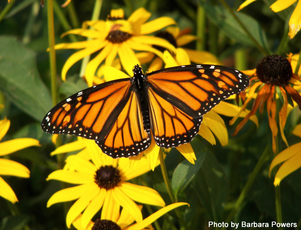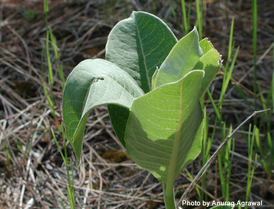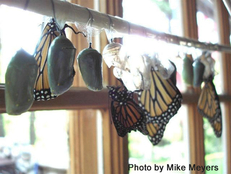Raising Flutters by Nancy Werner

No butterfly is more widely recognized throughout the United States than the regal Monarch butterfly. Sighting a monarch butterfly is a sure sign of warm weather and the best that summer has to offer, and the monarch's flight instincts have long been studied by and are a mystery to scientists the world over. But the fate of the monarch hangs in the balance.
My dad brought me 3 monarch caterpillars when I was a little girl. I watched them magically turn into chrysalis, and hatch days later into beautiful butterflies. That was 43 years ago. No longer a hobby, this is now my lifework and one of my avenues of stewardship. Indeed, how can so much life come from one tiny, pin-head sized egg?
This summer (2011), I raised 319 monarchs – 160 females and 159 males. I've always kept a log on them, and this year I officially logged my success rate of butterflies hatched from the chrysalis at 97.25%. Most of my “flutters” are raised from eggs. During all these years, I have discovered a myriad of methods that work to successfully raise monarch butterflies. I'd like to share my most effective of these with you, and encourage you to be a steward of this insect species. Anyone can raise butterflies, and the more people that raise them, the better their chances of survival.
Sources (eggs, caterpillars, leaves, and milkweed)
Milkweed can be found in large clumps, or individually-scattered plants. I have “sources” for milkweeds and monarchs ranging from my backyard, to my neighborhood, to northern Minnesota (“up North”), to miles south of the Twin Cities of Minneapolis and St. Paul. Many of my sources contain just a few plants (some as few as 2-3 plants) and often I have found the most eggs on individual or 1” to 3” plants. Eggs are usually laid underneath the leaf, but can also be laid on the top of the leaf or even on the buds that form the milkweed flowers. Signs of caterpillars eating leaves, as well as droppings, are C-shaped holes and different-sized holes in the leaves.
My dad brought me 3 monarch caterpillars when I was a little girl. I watched them magically turn into chrysalis, and hatch days later into beautiful butterflies. That was 43 years ago. No longer a hobby, this is now my lifework and one of my avenues of stewardship. Indeed, how can so much life come from one tiny, pin-head sized egg?
This summer (2011), I raised 319 monarchs – 160 females and 159 males. I've always kept a log on them, and this year I officially logged my success rate of butterflies hatched from the chrysalis at 97.25%. Most of my “flutters” are raised from eggs. During all these years, I have discovered a myriad of methods that work to successfully raise monarch butterflies. I'd like to share my most effective of these with you, and encourage you to be a steward of this insect species. Anyone can raise butterflies, and the more people that raise them, the better their chances of survival.
Sources (eggs, caterpillars, leaves, and milkweed)
Milkweed can be found in large clumps, or individually-scattered plants. I have “sources” for milkweeds and monarchs ranging from my backyard, to my neighborhood, to northern Minnesota (“up North”), to miles south of the Twin Cities of Minneapolis and St. Paul. Many of my sources contain just a few plants (some as few as 2-3 plants) and often I have found the most eggs on individual or 1” to 3” plants. Eggs are usually laid underneath the leaf, but can also be laid on the top of the leaf or even on the buds that form the milkweed flowers. Signs of caterpillars eating leaves, as well as droppings, are C-shaped holes and different-sized holes in the leaves.

Milkweed Leaves
Monarch caterpillars eat only milkweed leaves. I give my caterpillars only the best leaves – healthy, green ones with no dry spots, aphid-encrusted or yellow areas, or blemishes. I wipe off both sides of the leaf with a dry paper towel; this serves two purposes: 1) to check for any eggs and/or caterpillars on the leaves and 2) to make sure no predators (spiders, aphids, etc) are on the leaves.
I store leaves when needed in the refrigerator, cleaned off and with several leaves wrapped in a dry paper towel, in either one of the Ziplock containers with holes punched in the lid, or in a Ziplock bag. You may have to re-wipe the leaves off before using again, to remove “fridge moisture”.
BE CAREFUL not to feed your caterpillars leaves that have been sprayed (via mosquito control or other means)! While we are told these sprays are 'safe' for humans, they are definitely harmful to the monarch eggs and caterpillars. Watch where you gather your leaves- along highways and roadsides can be questionable, as well as recreational areas such as parks and campgrounds. At one of my local milkweed sources, I was able to tell that the leaves didn't feel quite right, but visually there was no sign of poison, except for two small newborn caterpillars that lay slowly writhing on the leaf.
Cages/Containers
For full-grown caterpillars that will be ready to crawl to the cage top and turn into chrysalis, my dad made me a special screen-enclosed cage with a wooden top with a round piece of screen on it, a wood bottom supported by dowel rods, and a cage door using two zippers placed perpendicular to each other. For eggs and smaller caterpillars, I use ZipLock containers (BPH-free and about 5” x 9) with blue lids with holes poked in the lids. It is important, whatever cage type or container you use, that air can get into the container.
Check when you carefully remove/replace the container lids or open the cage door that no caterpillars are in the way, so they don't get hurt. I usually leave any caterpillars that are on the lid that are molting, but am very careful when replacing the lid and if they are in the path of where the lids fastens, I move them to a leaf. I empty “droppings” (frass) out of the containers and wipe them out twice daily, first with a wet paper towel, then with a dry one. Sometimes people use a diluted bleach/water solution for this.
Where to Keep Your Containers
The cages and containers with caterpillars and chrysalis in them are kept on top of my stove top. When I need to use the stove top or oven during monarch season, I (of course!) transfer them to another spot until I'm done and the oven and/or cooktop surface are cool. I have a range hood, so I leave the light on in that until bedtime. An area with some amount of light is recommended, remembering that caterpillars do not like bright or direct sunlight on them. An even temperature in the area they are kept works well-not hot, not cold, by no furnace vents or air conditioning.
Monarch caterpillars eat only milkweed leaves. I give my caterpillars only the best leaves – healthy, green ones with no dry spots, aphid-encrusted or yellow areas, or blemishes. I wipe off both sides of the leaf with a dry paper towel; this serves two purposes: 1) to check for any eggs and/or caterpillars on the leaves and 2) to make sure no predators (spiders, aphids, etc) are on the leaves.
I store leaves when needed in the refrigerator, cleaned off and with several leaves wrapped in a dry paper towel, in either one of the Ziplock containers with holes punched in the lid, or in a Ziplock bag. You may have to re-wipe the leaves off before using again, to remove “fridge moisture”.
BE CAREFUL not to feed your caterpillars leaves that have been sprayed (via mosquito control or other means)! While we are told these sprays are 'safe' for humans, they are definitely harmful to the monarch eggs and caterpillars. Watch where you gather your leaves- along highways and roadsides can be questionable, as well as recreational areas such as parks and campgrounds. At one of my local milkweed sources, I was able to tell that the leaves didn't feel quite right, but visually there was no sign of poison, except for two small newborn caterpillars that lay slowly writhing on the leaf.
Cages/Containers
For full-grown caterpillars that will be ready to crawl to the cage top and turn into chrysalis, my dad made me a special screen-enclosed cage with a wooden top with a round piece of screen on it, a wood bottom supported by dowel rods, and a cage door using two zippers placed perpendicular to each other. For eggs and smaller caterpillars, I use ZipLock containers (BPH-free and about 5” x 9) with blue lids with holes poked in the lids. It is important, whatever cage type or container you use, that air can get into the container.
Check when you carefully remove/replace the container lids or open the cage door that no caterpillars are in the way, so they don't get hurt. I usually leave any caterpillars that are on the lid that are molting, but am very careful when replacing the lid and if they are in the path of where the lids fastens, I move them to a leaf. I empty “droppings” (frass) out of the containers and wipe them out twice daily, first with a wet paper towel, then with a dry one. Sometimes people use a diluted bleach/water solution for this.
Where to Keep Your Containers
The cages and containers with caterpillars and chrysalis in them are kept on top of my stove top. When I need to use the stove top or oven during monarch season, I (of course!) transfer them to another spot until I'm done and the oven and/or cooktop surface are cool. I have a range hood, so I leave the light on in that until bedtime. An area with some amount of light is recommended, remembering that caterpillars do not like bright or direct sunlight on them. An even temperature in the area they are kept works well-not hot, not cold, by no furnace vents or air conditioning.

Eggs and Caterpillars
I have several containers for different size caterpillars, as I have discovered that larger ones sometimes tend to eat the smaller ones. I keep the eggs in a separate container, as the caterpillars sometimes tend to eat the eggs. When I gather an egg from a milkweed plant, I either take the entire leaf or sometimes use a scissors to cut off a piece about 1” by 1” surrounding the egg. It takes about 5 days for eggs to hatch, so if you leave the whole leaf with the egg on it, it will start drying up and will be harder to locate the egg, as well as the tiny caterpillar when it hatches, and increase the danger of harming the tiny caterpillar. This also preserves more of the leaf that the egg was on.
To avoid overcrowding, I generally don't keep more than 12-15 full-grown caterpillars (pre-chrysalis) at a time in the large cage, and (depending on size) not more than 10 to 25 smaller caterpillars in the containers.
When to Feed Your Caterpillars
I transfer my caterpillars, using a colored toothpick, to fresh leaves twice a day: first thing in the morning, first thing at night (note: in the MonarchLab we feed our larvae once a day, except when they’re eating so much that we need more frequent feeding). I pick up the larger caterpillars carefully using my thumb and forefinger to move them. This method works well because the leaves tend to dry out in the containers . Caterpillars move around on and between plants in the wild so that they always are eating fresh leaves, so it is important to make sure that picked leaves are as fresh as possible. I've always kept count of the caterpillars, so transferring them to new leaves (as opposed to just laying new leaves on top of older leaves) is a good way to make sure they are all still there.
Chrysalis
Generally, it takes about 5 days for the eggs to hatch, about 2 weeks for the caterpillars to become full-grown, and about another 2 weeks for the butterfly to emerge once the caterpillar turns into its mint-green chrysalis.
When the caterpillar is ready to turn into a chrysalis, it will crawl (usually) to the top of your container, sit up there for a day or two, and then form a “J” when hanging. It will take another day or two for the caterpillar to shed its skin and turn into the chrysalis.
Sometimes a chrysalis will fall to the bottom of your cage/container. I keep some fresh leaves on the bottom of my cage even when all the caterpillars have turned into chrysalis, so if any fall they will have a “cushion” to fall on (note: in the MonarchLab, we put small sterile pieces of cloth screen as cushions and crawling surfaces for newly-emerged monarchs that fall, or for pupae). I have had success with many that have fallen off the cage top by keeping them in a separate and open bowl, then carefully inserting the tip of the chrysalis in between a piece of folded duct tape and taping them on one of the dowel rods on the side of my cage about 4-5” from the cage bottom (with a leaf underneath).
A Butterfly Emerges
When the butterfly is ready to emerge, the chrysalis will reveal the orange and black wing colors of the butterfly (the chrysalis will start to lean inwards and you will see about 2-3 ridges on its shorter side).
Note that sometimes a butterfly won't emerge-this is part of nature and no cause for alarm. Sometimes a chrysalis hatches and the butterfly's wings are not shaped properly or are folded abnormally.
I keep my flutters in the cage they hatched in for a few hours until their wings dry, then I transfer them to another cage (referred to as my “holding pond”!) so that they do not disturb any other chrysalis still in the cage (note: to prevent disease spread, it is important to keep caterpillars and emerging in separate cages). I keep them inside for at least a day, often two, and then release them in my backyard. I don't let them go at night, or if it is raining or inclement weather outside.
At the Monarch Lab we check each butterfly for a protozoan parasite Ophryocystis elektroscirrha, or OE. To learn more about how to sample your butterflies for OE visit Project Monarch Health.
Raising Monarch butterflies is not only the best “miracle of birth” experience ever, it is a positive way to help the monarchs survive, help our ecosystem, and ensure that these little winged miracles fly among us for years to come.
I hope you fly! ---Nancy Werner
(This content is used with permission of Nancy Werner, University of Minnesota Monarch Lab)
I have several containers for different size caterpillars, as I have discovered that larger ones sometimes tend to eat the smaller ones. I keep the eggs in a separate container, as the caterpillars sometimes tend to eat the eggs. When I gather an egg from a milkweed plant, I either take the entire leaf or sometimes use a scissors to cut off a piece about 1” by 1” surrounding the egg. It takes about 5 days for eggs to hatch, so if you leave the whole leaf with the egg on it, it will start drying up and will be harder to locate the egg, as well as the tiny caterpillar when it hatches, and increase the danger of harming the tiny caterpillar. This also preserves more of the leaf that the egg was on.
To avoid overcrowding, I generally don't keep more than 12-15 full-grown caterpillars (pre-chrysalis) at a time in the large cage, and (depending on size) not more than 10 to 25 smaller caterpillars in the containers.
When to Feed Your Caterpillars
I transfer my caterpillars, using a colored toothpick, to fresh leaves twice a day: first thing in the morning, first thing at night (note: in the MonarchLab we feed our larvae once a day, except when they’re eating so much that we need more frequent feeding). I pick up the larger caterpillars carefully using my thumb and forefinger to move them. This method works well because the leaves tend to dry out in the containers . Caterpillars move around on and between plants in the wild so that they always are eating fresh leaves, so it is important to make sure that picked leaves are as fresh as possible. I've always kept count of the caterpillars, so transferring them to new leaves (as opposed to just laying new leaves on top of older leaves) is a good way to make sure they are all still there.
Chrysalis
Generally, it takes about 5 days for the eggs to hatch, about 2 weeks for the caterpillars to become full-grown, and about another 2 weeks for the butterfly to emerge once the caterpillar turns into its mint-green chrysalis.
When the caterpillar is ready to turn into a chrysalis, it will crawl (usually) to the top of your container, sit up there for a day or two, and then form a “J” when hanging. It will take another day or two for the caterpillar to shed its skin and turn into the chrysalis.
Sometimes a chrysalis will fall to the bottom of your cage/container. I keep some fresh leaves on the bottom of my cage even when all the caterpillars have turned into chrysalis, so if any fall they will have a “cushion” to fall on (note: in the MonarchLab, we put small sterile pieces of cloth screen as cushions and crawling surfaces for newly-emerged monarchs that fall, or for pupae). I have had success with many that have fallen off the cage top by keeping them in a separate and open bowl, then carefully inserting the tip of the chrysalis in between a piece of folded duct tape and taping them on one of the dowel rods on the side of my cage about 4-5” from the cage bottom (with a leaf underneath).
A Butterfly Emerges
When the butterfly is ready to emerge, the chrysalis will reveal the orange and black wing colors of the butterfly (the chrysalis will start to lean inwards and you will see about 2-3 ridges on its shorter side).
Note that sometimes a butterfly won't emerge-this is part of nature and no cause for alarm. Sometimes a chrysalis hatches and the butterfly's wings are not shaped properly or are folded abnormally.
I keep my flutters in the cage they hatched in for a few hours until their wings dry, then I transfer them to another cage (referred to as my “holding pond”!) so that they do not disturb any other chrysalis still in the cage (note: to prevent disease spread, it is important to keep caterpillars and emerging in separate cages). I keep them inside for at least a day, often two, and then release them in my backyard. I don't let them go at night, or if it is raining or inclement weather outside.
At the Monarch Lab we check each butterfly for a protozoan parasite Ophryocystis elektroscirrha, or OE. To learn more about how to sample your butterflies for OE visit Project Monarch Health.
Raising Monarch butterflies is not only the best “miracle of birth” experience ever, it is a positive way to help the monarchs survive, help our ecosystem, and ensure that these little winged miracles fly among us for years to come.
I hope you fly! ---Nancy Werner
(This content is used with permission of Nancy Werner, University of Minnesota Monarch Lab)

